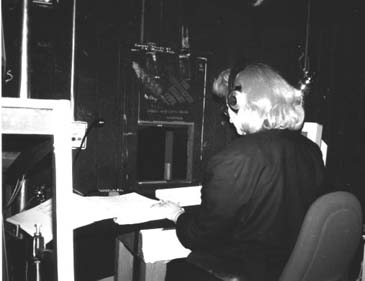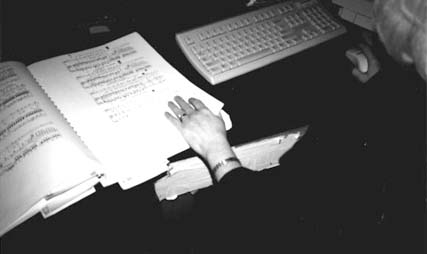



A laptop Macintosh PowerBook 540C is used to create the Surtitles™ for performances by The Washington Opera at the Kennedy Center in Washington, D.C.
The Surtitles are translations of both the sung and spoken dialog in the opera. These are projected on a small wide screen at the top of the stage. For those who do not understand the language of the opera, typically Italian, German, or French, the titles make it easy for anyone to follow the story line and understand what the characters are so worked up about. The progressive opera company, including The Washington Opera, even uses the Surtitles for a work sung in English! The reason is that many singers' words cannot be understood even when they sing in your own language. This is truer for female singers than male. The singer is striving for pure tone, which comes from the vowels. Consonants, so necessary for diction, just get in the way and are largely glossed over.
Surtitles is a trade name. The generic term is supertitles (over the image), as opposed to subtitles (under the image) as seen in foreign language movies.
In the "old" days - for The Washington Opera, more than three years ago - Surtitles were made on slides and two slide projectors were used to project them on the screen. This was an expensive and tedious process involving photography, processing, and sorting into projector trays. Trouble came when a new title had to be inserted and shifting of a lot of slides was required. The new system sends the titles directly from a computer to a very large video projector. Therefore, making changes in the titles is quite easy. The projectors are shown in Figs. 1 and 2. They are made by Barco, a company in Belgium.

Barco video projectors from the audience side of the booth. Note large follow spotlight projector at right.
The Barco projectors are of a class very different from the LCD projectors we are more familiar with. The Barcos have a strange CRT (cathode ray tube) arrangement in which the electron beam impinges on an oil film instead of a screen. The impact of the beam creates tiny deformations in the oil film. A very powerful Xenon lamp illuminates the oil film. Its image is then transmitted through diffraction gratings in a so-called Schlieren system, the details of which the author does not understand. The magically reconstituted image is then focused by the optical system on the screen above the stage.

Rear view of Barco video projectors. Note the Opera House ceiling lights through the window at the top. The picture may show the words "hear you!" at the top. That's the end of an instruction to booth techs saying, "Speak softly; audience can hear you!"
The beauty of this system is that changes: insertions, alterations, or deletions can easily be made in the computer even at the last minute.
I interviewed the Surtitles expert, Mrs. Cathryn Dowd, at the Kennedy Center to learn all I have been wanting to know for several years. The occasion for the interview was a "Look-in," a presentation of opera for area school children. Each season The Washington Opera has six Look-ins, each time filling the Opera House at the Kennedy Center with 2,200 children. Volunteers who visit the schools brief these children in the opera they will see. The children even act out parts of the opera story to become familiar with it. At the Look-in, the mistress of ceremonies first tells and shows the children how some special effects are done. They particularly liked the smoke, fire, and explosions. They also saw snow falling, lightening, and the thunder maker, large flexible metal sheets. She then tells a little of the story and a performance begins.
For this Look-in four scenes from Don Giovanni were performed. There was a full orchestra. The stage sets and costumes were all the real thing. The singers were not the stars of the regular show but were professional singers who were quite good. Surtitles were used as usual.
The source material for the Surtitles is typically a piano score of the whole opera. As opposed to the orchestral score which shows all the instruments, the piano score shows only the "bones" of the music as well as all of the libretto; that’s Italian for the lyrics. A translator translates short sections of the libretto and places the words above the music staff usually just ahead of start of the sung words. Sometimes the score and the translations come with an opera production of another opera company and sometimes the translations are done locally especially for productions originated by The Washington Opera.
Mrs. Dowd uses a PowerBook 540C and Microsoft PowerPoint for the Surtitles. She sometimes does the translations and enters the Surtitles into PowerPoint. Sometimes the Surtitles come on a disk with the opera from another opera company. If they are from a program she can use, such as Word, she can send them directly to PowerPoint. If not, she must type them in. Each Surtitle is a "presentation" slide.

Mrs. Cathryn Dowd at her desk running the Surtitles. She can see the stage through the small window in front of her. Her sole source of light is the tiny goose neck lamp over the score.
A black title is inserted between each text title and the next text title. The reason is that it takes much less time to read the title than it takes for the singer to sing it. And the black title gets your eyes off of the title screen and back on the singer! About five or six title pairs, black and text, appear on Mrs. Dowd’s computer screen. The active title is marked. She usually pushes the Enter button to select the next title. She can also scroll and select any title at random to be shown. The title is timed to appear slightly ahead of the sung words to give you the sense that you understand the singer’s words. Sometimes the black title is replaced by an "effects" title that allows fadeins and fadeouts. The timing magic is the result of Mrs. Dowd’s multitalents. She can read the music and hears the singer’s words and knows when to push the button for the next title. There is a microphone hidden in center stage connected to a private line to Mrs. Dowd’s earphones so she can hear the voices before they go out over the orchestra. She sits above the balcony in the "follow spot" booth (with the spotlights). See Fig. 3. She can see the stage through the small window in front of her. Fig. 4 is a closer view of Mrs. Dowd’s desk. On the piano score you may see some black dots above the musical staff. These are the points at which the Surtitles are to be sent to the screen.

Closeup of Surtitles desk. You may see black dots over the music staffs. Each one indicates the start point for a Surtitle.
I was in the booth for the entire show and saw it through the spotlight windows and heard it through a small loudspeaker.
When Mrs. Dowd is at home creating titles and entering them in her PowerBook, she is an artist and she is paid by The Washington Opera. When she is in the booth and "pushes a button," she is a stagehand - though still an artist - belonging to the Stagehand’s Union, Local 22 and is paid by the Kennedy Center, which in turn bills The Washington Opera.
Originally, Mrs. Dowd brought her PowerBook to the Kennedy Center for each show and connected it to the projector. Because of concern for reliability a Wintel Micron Millennium computer was purchased to be dedicated to the task in the Surtitles booth. The PowerBook continues to be used to create the Surtitles in PowerPoint. These are brought in and played in PowerPoint on the PC. The concern for reliability also brought in the second projector, which is strictly standby, always on line ready to go. Alternating between projectors as with slide projectors is not done.
One story is about the time the computer played a trick. They were having a little trouble that seemed to be associated with the computer. The technical director suggested using his PowerBook, which was identical to Mrs. Dowd’s. He forgot to tell her one little thing. It was during the final moments of the final scene in La Boheme. Mimi, the heroine, is lying in bed dying. She is singing, "Please, Rudolpho, don’t leave me." Mrs. Dowd pushed the button and the next title that came up said, "Your battery is running low and the screen has been dimmed." I quote Mrs. Dowd, "In front of the audience. Yes, absolutely. And the audience went nuts. They thought it was the funniest... You know she was dying...the end of the show...she’s dying. The audience just roared." What the technical director failed to tell her was that his laptop sometimes reported low battery even when it was plugged into the AC outlet, which it was during Boheme! At this point they bought a dedicated computer.
Another incident occurred during the showing of Electra. It is in German with all the angst. If you don’t know the story, you really rely on Surtitles. It is in one act with no intermission. Halfway through one of the performances the projector blew and there was no backup at the time. There was almost a riot. People missed half of the show. Some demanded their money back. At this point they bought a second projector.
This is particularly interesting because, when translation titles were first suggested, people thought that it was tacky. If you didn’t know the story and couldn’t follow it during the performance, you were just out of it and didn’t deserve to be at the opera. There was also objection that the titles distracted the audience from the singer. However, the use of titles has greatly enlarged the opera audience.
As an opera buff and a regular at The Washington Opera, I now have a greater appreciation for the Surtitles. Y’all ought to come to the opera; you don’t know what you’re missing!
Minimum requirements for viewing opera:
Any model with current operating system
20 MB of music loving RAM
300 MB of singing loving hard disk space
![]()
Revised Saturday, August 12, 1998 Lawrence I.
Charters
Washington Apple Pi
URL: http://www.wap.org/journal/